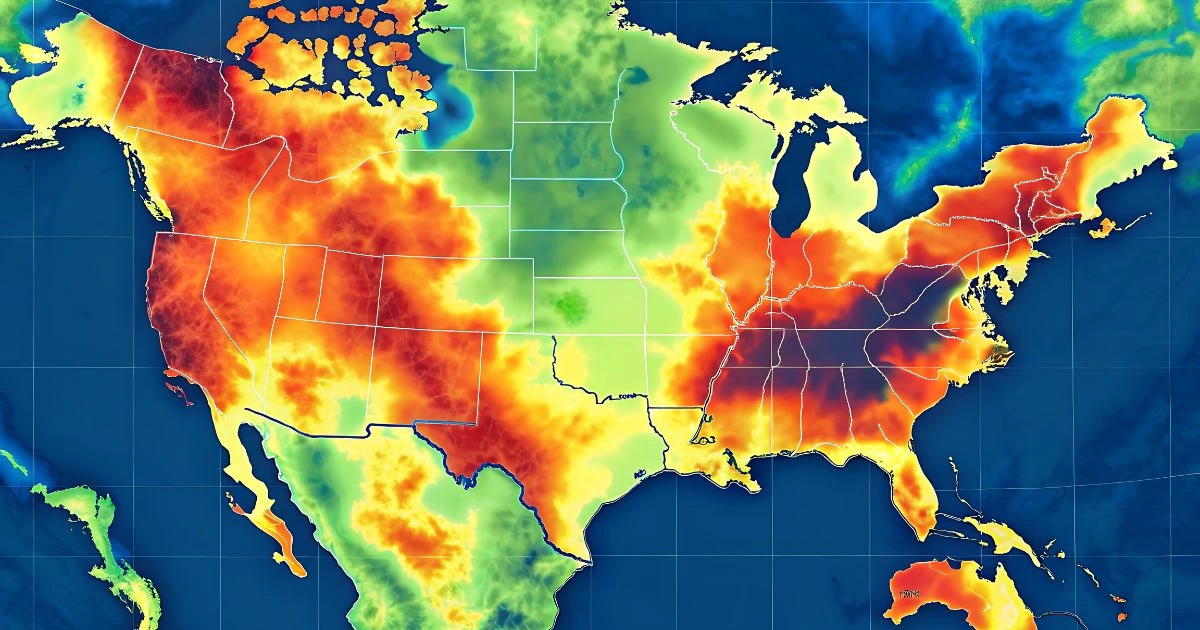As temperatures across the U.S. soar to new heights, it’s crucial to stay informed about extreme weather events, such as heatwaves. With more frequent heatwaves, many areas are under extreme heat warnings. Or heat advisories. These warnings aren’t just weather alerts – they signal serious risks to health and safety. Understanding what these warnings mean and how to protect yourself is crucial, especially as climate change continues to intensify and increase the frequency of extreme heat events.
What is an Extreme Heat Warning?
An extreme heat warning is issued when conditions are forecast to be dangerously hot, often resulting in life-threatening conditions, particularly if individuals are not prepared. This could include temperatures rising above 100°F (37°C), combined with high humidity levels that make the air feel even hotter. These warnings are typically issued for a prolonged period, lasting several days or even weeks, and are a call to action to take immediate precautions.
While the exact criteria can vary by region, an extreme heat warning typically occurs when the heat index (a measure that combines temperature and humidity) is expected to reach 105°F (40°C) or higher. This can be especially dangerous for vulnerable populations like children, the elderly, and people with pre-existing health conditions.
Heat Advisory vs. Extreme Heat Warning
While both heat advisories and extreme heat warnings indicate hot weather, the difference lies in the severity of the conditions.
-
Heat Advisory: A heat advisory is issued when the heat index is expected to be dangerously high, but not to the extreme levels of a warning. It is a precautionary message, urging people to take steps to stay calm and hydrated. Typically, heat advisories are issued when temperatures reach 95°F (35°C) or higher.
-
Extreme Heat Warning: This is a more severe warning, indicating that heat conditions could pose significant health risks. It’s usually issued when temperatures exceed 100°F (37°C) or when heat indices are forecasted to reach dangerous levels for an extended period.
Why Are Heatwaves Becoming More Frequent?
The increasing frequency of extreme heat warnings and heat advisories is directly linked to climate change. Rising global temperatures, changing weather patterns, and urbanization all contribute to more intense and prolonged heat events.
As cities grow and more concrete and asphalt replace natural vegetation, the urban heat island effect exacerbates the heat. Urban areas can be up to 10°F (5.5°C) warmer than surrounding rural areas, making heatwaves even more dangerous.
Moreover, climate change is causing more erratic weather patterns, which means heatwaves are becoming more unpredictable and widespread, with cities experiencing extreme temperatures earlier in the summer or for longer durations.
Health Risks During Extreme Heat
The human body is designed to regulate its temperature through sweating, but when temperatures become extreme, it struggles to maintain a safe internal temperature. Exposure to extreme heat without proper precautions can lead to heat-related illnesses, such as:
-
Heat Exhaustion: Symptoms include heavy sweating, weakness, dizziness, nausea, and fainting. It’s essential to hydrate and cool down immediately if these symptoms occur.
-
Heat Stroke: A medical emergency, heat stroke happens when the body’s temperature rises above 104°F (40°C). Symptoms include confusion, rapid heartbeat, and loss of consciousness. Immediate medical attention is necessary to avoid severe consequences.
-
Dehydration: Excessive heat causes the body to lose fluids quickly, leading to dehydration. Symptoms include dry mouth, fatigue, and confusion.
How to Stay Safe During a Heat Advisory or Extreme Heat Warning?
During a heat advisory or extreme heat warning, it’s crucial to take proactive steps to protect yourself. Here are some tips to stay safe:
1. Stay Hydrated
Dehydration is one of the most significant health risks during extreme heat. Drink plenty of water throughout the day, even if you don’t feel thirsty. Avoid alcoholic beverages and drinks high in caffeine, as these can dehydrate you further. For more information on staying hydrated, visit the CDC’s Heat Safety Tips.
2. Limit Outdoor Activities
Avoid strenuous outdoor activities during the hottest parts of the day, typically between 10 a.m. and 4 p.m. If you must be outdoors, take frequent breaks in the shade and wear a wide-brimmed hat and sunscreen to protect yourself from the sun.
3. Stay Indoors and Use Air Conditioning
The best way to avoid the risks of extreme heat is to stay in air-conditioned environments. If your home doesn’t have air conditioning, consider visiting public places like shopping malls, libraries, or community centers, which are often cooler. Learn more about cooling resources at ready.gov.
4. Wear Lightweight, Light-Colored Clothing
Wear loose-fitting, light-colored clothing made from natural fabrics, such as cotton, which allow your skin to breathe. This helps your body stay cool by allowing sweat to evaporate more easily.
5. Check on Vulnerable Neighbors
Elderly neighbors or those with pre-existing health conditions may not recognize the dangers of extreme heat or may be unable to effectively cool their homes. Regularly check on them to ensure they’re safe and have access to cooling resources.
6. Know the Signs of Heat-Related Illnesses
Learn to recognize the symptoms of heat exhaustion and heat stroke. If you or someone you know shows signs of heat-related illnesses, seek medical attention immediately.
What Communities and Governments Are Doing to Help?
Governments and communities play a critical role in managing the impacts of extreme heat. Local authorities often issue heat advisories and extreme heat warnings, which are broadcast via radio, TV, and smartphone apps to help residents prepare. Additionally:
-
Cooling Centers: Many cities open cooling centers, which are public spaces where people can go to escape the heat. For more information, you can visit the American Red Cross.
-
Emergency Services: Some areas set up emergency services to provide assistance to vulnerable populations during extreme heat events.
-
Public Awareness Campaigns: Educational campaigns inform residents about the risks of extreme heat and provide safety guidelines. The National Weather Service is a valuable resource for timely updates and alerts.
Conclusion
With climate change leading to more frequent and intense heatwaves, it’s essential to understand the dangers of extreme heat warnings and heat advisories. By staying informed, taking the proper precautions, and helping vulnerable individuals, you can protect yourself and others during extreme heat events. Remember, heat can be deadly – taking proactive steps to stay calm and hydrated is key to staying safe. (TectUs Blog)






